It looks like you're using an Ad Blocker.
Please white-list or disable AboveTopSecret.com in your ad-blocking tool.
Thank you.
Some features of ATS will be disabled while you continue to use an ad-blocker.
share:
The French Mystery Cult of Mary Magdalene attracted much interest in recent years with the general scenario that she was the wife of Jesus, they
produced offspring, and this led to a tradition of a secret Bloodline...i think that's wrong...and will present here my own considerations.
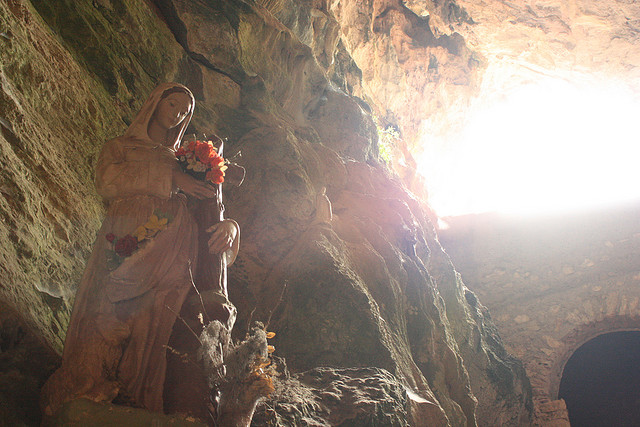
The tradition of Mary Magdalene in France was compiled into the Golden Legend
The Golden Legend
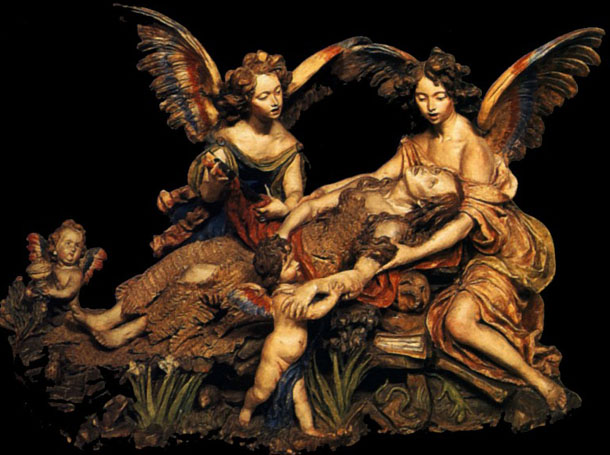
Above one sees a representation of the death of Mary Magdalene in the cave at Baume, were in legend she had chosen to live out her years in the wilderness, after landing at Marseille.
Here's a painting on the same theme, the common element being the skull;
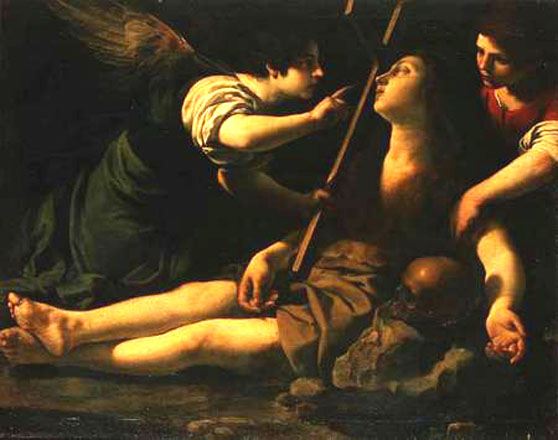
There are four general artifacts that will be seen in association with this theme, a book, the skull, an ointment jar and cross with pronounced vertical proportions.

What Mary sought in the cave was perfect knowledge, the light...
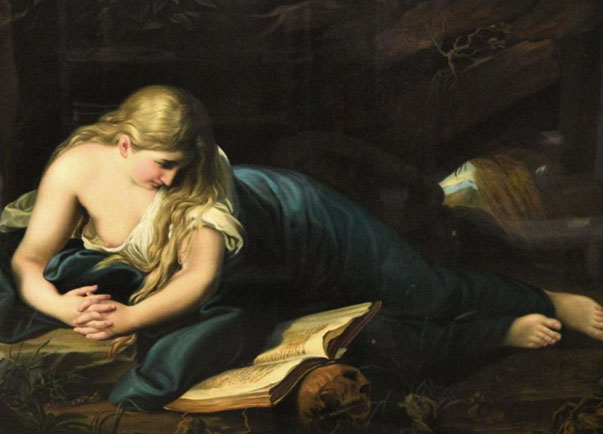
Her means to achieving this were her artifacts, the skull, the books, the axis of the cross;
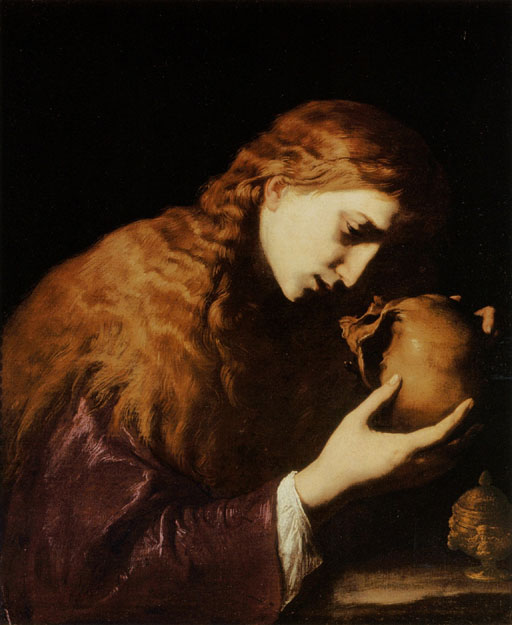
And through these Mary became enlightened;
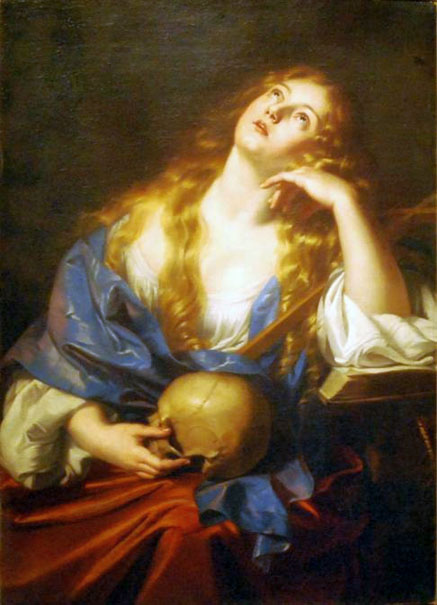
Through the ointment jar with which she had annointed Jesus as the Messiah, she contemplated the relationship of the physical to the metaphysical and Divine;
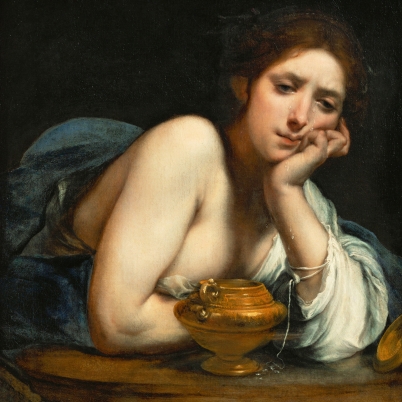
and came to realise the purity of the physical reflecting the Heavenly;
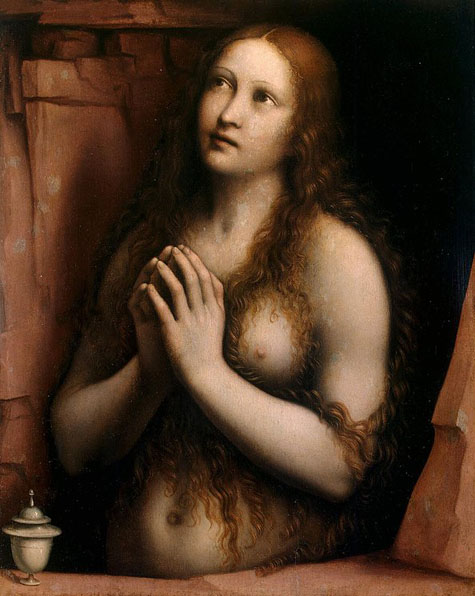
Her closest relationship was to the skull, the evidence would suggest this relates to the skull of Jesus itself, it was her love and she rejected all others;
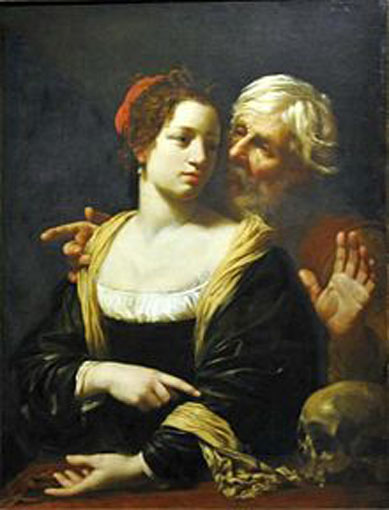
nor had need of any child...
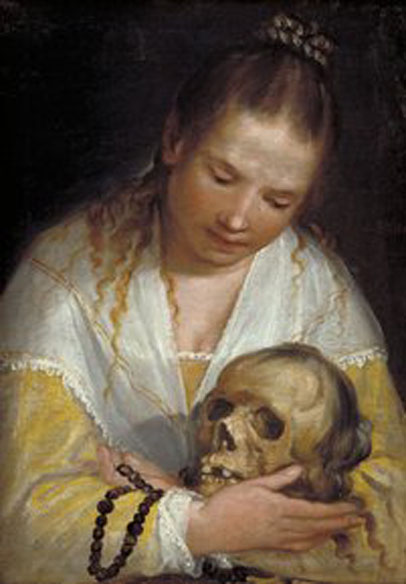
It's a remarkable cult and i love the associated images of Mary transforming into this wise woman;
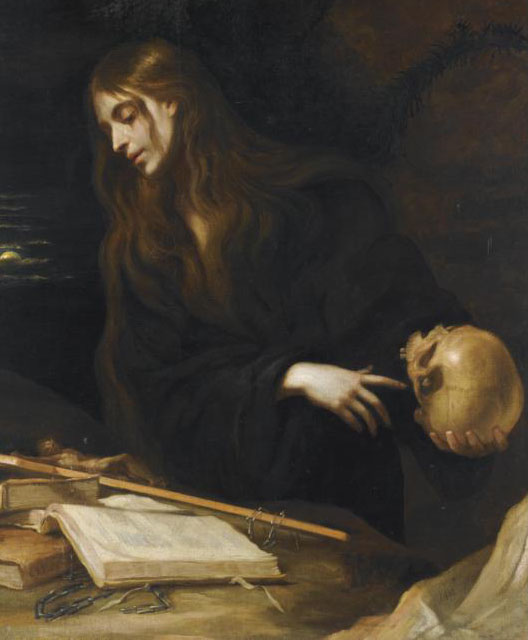
Historians will doubt the veracity of the legend, citing the counter tradition of the early church that Mary Magdalene lived out her days at Ephesus in Turkey, along with Mary the Mother of Jeus and the apostle John, but it is actually there that the strength of the French tradition lies, in that at Marseille were Mary is said to have landed was a sister Temple of Artemis of Ephesus;
The common denominator then between the two traditions is the Temple of Artemis, and from the Golden Legend;
they came all to Marseilles, where, as none would receive them to be lodged, they dwelled and abode under a porch tofore a temple of the people of that country
Mary Magdalene is reflecting an aspect of the cult of Artemis, not the Mother Goddess aspect or Goddess of fertility, but that of sister to Apollo, the cosmic balance.
Apollo was master of a metaphysical cosmic axis that reached into the darkest depths and scaled the most brilliant heights, as symbolised by the extended vertical cross, his sister was the axis of horizontal balance, a harmonious relationship.
Mary Magdalene Gospel
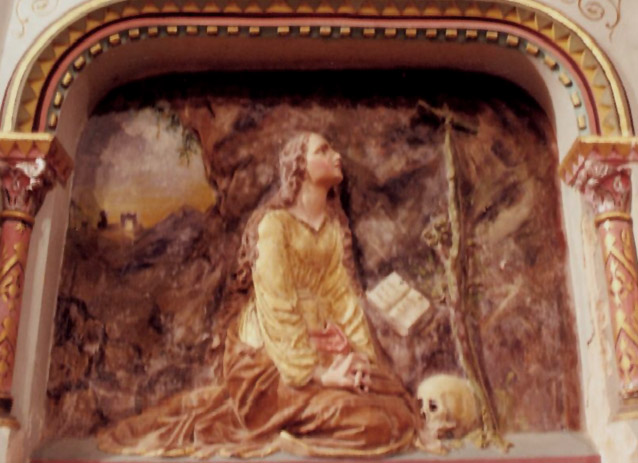

The tradition of Mary Magdalene in France was compiled into the Golden Legend
The Golden Legend
...
And this is she, that same Mary Magdalene to whom our Lord gave so many great gifts. And showed so great signs of love, that he took from her seven devils. He embraced her all in his love, and made her right familiar with him. He would that she should be his hostess, and his procuress on his journey
There was that time with the apostles Saint Maximin, which was one of the seventy-two disciples of our Lord, to whom the blessed Mary Magdalene was committed by Saint Peter, and then, when the disciples were departed, Saint Maximin, Mary Magdalene, and Lazarus her brother, Martha her sister, Marcelle, chamberer of Martha, and Saint Cedony which was born blind, and after enlumined of our Lord; all these together, and many other christian men were taken of the miscreants and put in a ship in the sea, without any tackle or rudder, for to be drowned. But by the purveyance of Almighty God they came all to Marseilles, where, as none would receive them to be lodged, they dwelled and abode under a porch tofore a temple of the people of that country
.

Above one sees a representation of the death of Mary Magdalene in the cave at Baume, were in legend she had chosen to live out her years in the wilderness, after landing at Marseille.
Here's a painting on the same theme, the common element being the skull;

There are four general artifacts that will be seen in association with this theme, a book, the skull, an ointment jar and cross with pronounced vertical proportions.

What Mary sought in the cave was perfect knowledge, the light...
is a lighter, for there she took so largely that she spread it abundantly. She took the light there, with which after she enlumined other, and in that she chose the best part of the heavenly glory, she is called the light. For then she was enlumined of perfect knowledge in thought, and with the light in clearness of body. Magdalene is as much as to say as abiding culpable. Or Magdalene is interpreted as closed or shut, or not to be overcome. Or full of magnificence, by which is showed what she was tofore her conversion, and what in her conversion, and what after her conversion

Her means to achieving this were her artifacts, the skull, the books, the axis of the cross;

And through these Mary became enlightened;

Through the ointment jar with which she had annointed Jesus as the Messiah, she contemplated the relationship of the physical to the metaphysical and Divine;

and came to realise the purity of the physical reflecting the Heavenly;

Her closest relationship was to the skull, the evidence would suggest this relates to the skull of Jesus itself, it was her love and she rejected all others;

nor had need of any child...

It's a remarkable cult and i love the associated images of Mary transforming into this wise woman;

Historians will doubt the veracity of the legend, citing the counter tradition of the early church that Mary Magdalene lived out her days at Ephesus in Turkey, along with Mary the Mother of Jeus and the apostle John, but it is actually there that the strength of the French tradition lies, in that at Marseille were Mary is said to have landed was a sister Temple of Artemis of Ephesus;
MASSILIA (Marseilles) City in Gaul (Greek Colony)
Strabo, Geography 4. 1. 4 :
"Massilia [in Gaul] was founded by the [Greek] Phokaians, and it is situated on a rocky place. Its harbour lies at the foot of a theatre-like rock which faces south … It is on the headland that the Ephesion [temple of Artemis Ephesia] and also a temple of Apollon Delphinios (of the Dolphins) are situated. The latter is shared in common by all Ionians, whereas the Ephesion is a temple dedicated solely to Artemis Ephesia (of Ephesos): for when the Phokaians were setting sail from their homeland an oracle was delivered to them, it is said, to use for their voyage a guide received from Artemis Ephesia; accordingly, some of them put in at Ephesos and inquired in what way they might procure from the goddess what had been enjoined upon them. Now the goddess, in a dream, it is said, had stood beside Aristarkha, one of the women held in very high honour, and commanded her to sail away with the Phokaians, taking with her a certain reproduction [of the main statue of Artemis Ephesia] which was among the sacred images; this done and the colony finally settled, they not only established the temple but also did Aristarkha the exceptional honour of appointing her priestess; further, in the colonial cities [of Massilia] the people everywhere do this goddess honours of the first rank, and they preserve the artistic design of the ‘xoanon’ [primitive wooden images which were supposed to have originally fallen from heaven] the same, and all the other usages precisely the same as is customary in the mother-city."
The common denominator then between the two traditions is the Temple of Artemis, and from the Golden Legend;
they came all to Marseilles, where, as none would receive them to be lodged, they dwelled and abode under a porch tofore a temple of the people of that country
Mary Magdalene is reflecting an aspect of the cult of Artemis, not the Mother Goddess aspect or Goddess of fertility, but that of sister to Apollo, the cosmic balance.
Apollo was master of a metaphysical cosmic axis that reached into the darkest depths and scaled the most brilliant heights, as symbolised by the extended vertical cross, his sister was the axis of horizontal balance, a harmonious relationship.
5) Peter said to Mary, Sister we know that the Savior loved you more than the rest of woman.
6) Tell us the words of the Savior which you remember which you know, but we do not, nor have we heard them.
7) Mary answered and said, What is hidden from you I will proclaim to you.
8) And she began to speak to them these words: I, she said, I saw the Lord in a vision and I said to Him, Lord I saw you today in a vision. He answered and said to me,
9) Blessed are you that you did not waver at the sight of Me. For where the mind is there is the treasure.
Mary Magdalene Gospel

reply to post by Kantzveldt
You found some pretty hot Mary Magdalene's there. S&F for that alone - but you've made a very good OP and brought up some interesting points (pun intended). I think the Dan Brown book and all the publicity for Mary Mag. that came with and after that have propelled her into the top tier of feminist icons, and she'll be a new meme for awhile. I like the skull emphasis, interesting connections, and it's a symbol of Mary M I've not noticed or remember reading about before. Probably have come across it, but all the pics of the artwork in one place make the symbol of the skull and its connection to her clear, thanks for collecting these.
You found some pretty hot Mary Magdalene's there. S&F for that alone - but you've made a very good OP and brought up some interesting points (pun intended). I think the Dan Brown book and all the publicity for Mary Mag. that came with and after that have propelled her into the top tier of feminist icons, and she'll be a new meme for awhile. I like the skull emphasis, interesting connections, and it's a symbol of Mary M I've not noticed or remember reading about before. Probably have come across it, but all the pics of the artwork in one place make the symbol of the skull and its connection to her clear, thanks for collecting these.
edit on 29-3-2013 by Aleister because: (no reason given)
Originally posted by Aleister
reply to post by Kantzveldt
You found some pretty hot Mary Magdalene's there. S&F for that alone - but you've made a very good OP and brought up some interesting points (pun intended). I think the Dan Brown book and all the publicity for Mary Mag. that came with and after that have propelled her into the top tier of feminist icons, and she'll be a new meme for awhile. I like the skull emphasis, interesting connections, and it's a symbol of Mary M I've not noticed or remember reading about before. Probably have come across it, but all the pics of the artwork in one place make the symbol of the skull and its connection to her clear, thanks for collecting these.
edit on 29-3-2013 by Aleister because: (no reason given)
eeek feminists....
Lets not forget that Mary Magdalene was a harlot to begin with.
I wonder how much harlots cost back in those days......?
Originally posted by resoe26
Originally posted by Aleister
reply to post by Kantzveldt
You found some pretty hot Mary Magdalene's there. S&F for that alone - but you've made a very good OP and brought up some interesting points (pun intended). I think the Dan Brown book and all the publicity for Mary Mag. that came with and after that have propelled her into the top tier of feminist icons, and she'll be a new meme for awhile. I like the skull emphasis, interesting connections, and it's a symbol of Mary M I've not noticed or remember reading about before. Probably have come across it, but all the pics of the artwork in one place make the symbol of the skull and its connection to her clear, thanks for collecting these.
edit on 29-3-2013 by Aleister because: (no reason given)
eeek feminists....
Lets not forget that Mary Magdalene was a harlot to begin with.
I wonder how much harlots cost back in those days......?
No, not a harolot or prostitute, you've bought into the catholic myth which was an attempt to marginalize her and her time with Jesus and major role as a female apostle afterwards. At least according to biblical expert Dan Brown.
reply to post by Aleister
Yes the skull is the most important aspect of her cult, that which she would not be parted from and was reunited with in death...
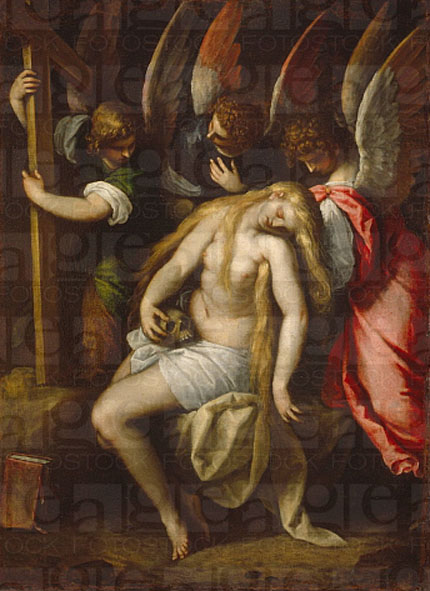
Yes the skull is the most important aspect of her cult, that which she would not be parted from and was reunited with in death...

reply to post by Kantzveldt
So If the skull was Jesus that would disprove the resurrection wouldn't it? thus disproving the whole Christian doctrine.
No wonder they tried to tarnish her.
Oh and I love the paintings
So If the skull was Jesus that would disprove the resurrection wouldn't it? thus disproving the whole Christian doctrine.
No wonder they tried to tarnish her.
Oh and I love the paintings
edit on 29-3-2013 by boymonkey74 because: (no reason given)
Originally posted by Aleister
Originally posted by resoe26
Originally posted by Aleister
reply to post by Kantzveldt
You found some pretty hot Mary Magdalene's there. S&F for that alone - but you've made a very good OP and brought up some interesting points (pun intended). I think the Dan Brown book and all the publicity for Mary Mag. that came with and after that have propelled her into the top tier of feminist icons, and she'll be a new meme for awhile. I like the skull emphasis, interesting connections, and it's a symbol of Mary M I've not noticed or remember reading about before. Probably have come across it, but all the pics of the artwork in one place make the symbol of the skull and its connection to her clear, thanks for collecting these.
edit on 29-3-2013 by Aleister because: (no reason given)
eeek feminists....
Lets not forget that Mary Magdalene was a harlot to begin with.
I wonder how much harlots cost back in those days......?
No, not a harolot or prostitute, you've bought into the catholic myth which was an attempt to marginalize her and her time with Jesus and major role as a female apostle afterwards. At least according to biblical expert Dan Brown.
Well yeah, I was raised Catholic.
---and bible expert Dan Brown?
how can ANYONE be an "expert" with the Bible? People still to this day have trouble 'decoding' the book of Revelation.
-everyone gets thier 'own' individual opinions by simply reading the book. Doesn't mean they need to force thier opinions on others.
anyone that calls themselves an expert on the Bible is egotistical.
reply to post by boymonkey74
Mary's possesion of the actual skull of Jesus does of course contradict the resurrection passage, thought to be a later addition, and the doctrine of the re-constitution of the physical body and Heavenly ascent...it would suggest a rebirth in spiritual form of more importance, after Gnostic doctrine.
reply to post by resoe26
That was based on confusion of the cult of Mary of Egypt from the first centuries with that of Mary Magdalene, as to how much she charged...
en.wikipedia.org...
Not much...
Mary's possesion of the actual skull of Jesus does of course contradict the resurrection passage, thought to be a later addition, and the doctrine of the re-constitution of the physical body and Heavenly ascent...it would suggest a rebirth in spiritual form of more importance, after Gnostic doctrine.
reply to post by resoe26
That was based on confusion of the cult of Mary of Egypt from the first centuries with that of Mary Magdalene, as to how much she charged...
Saint Mary, also known as Maria Aegyptica, was born somewhere in Egypt, and at the age of twelve ran away to the city of Alexandria where she lived an extremely dissolute life, prostituting herself.[3] In her Vita she states that she often refused the money offered for her sexual favors as she was driven "by an insatiable and an irrepressible passion," and that she mainly lived by begging, supplemented by spinning flax.
en.wikipedia.org...
Not much...
edit on 29-3-2013 by Kantzveldt because: (no reason given)
reply to post by Kantzveldt
So the Resurrection story was a later addition? never knew that cheers I bet that will annoy many Christians on here
So the Resurrection story was a later addition? never knew that cheers I bet that will annoy many Christians on here
reply to post by Kantzveldt
Having the skull of Jesus would "prove" that she was his wife, because who else would have legit claim to the skull! Maybe that's what the paintings and symbolism were and are hinting at the whole time. (and some things are obviously satire, as is my Dan Brown reference)
Having the skull of Jesus would "prove" that she was his wife, because who else would have legit claim to the skull! Maybe that's what the paintings and symbolism were and are hinting at the whole time. (and some things are obviously satire, as is my Dan Brown reference)
I do think that the early Christians and the people who made it into a Religion missed out Magdalene or tarnished her because she is a woman, the
bible and other religious texts speak of women like 2nd class citizens and only in the past 100 years or so have women been able to try and be equal
to men. (as they should be)
reply to post by boymonkey74
en.wikipedia.org...
reply to post by Aleister
There is of course a very strong romantic aspect to her attatchment to the skull, and of course it was considered he loved her the most so certainly the relationship was of the closest kind.
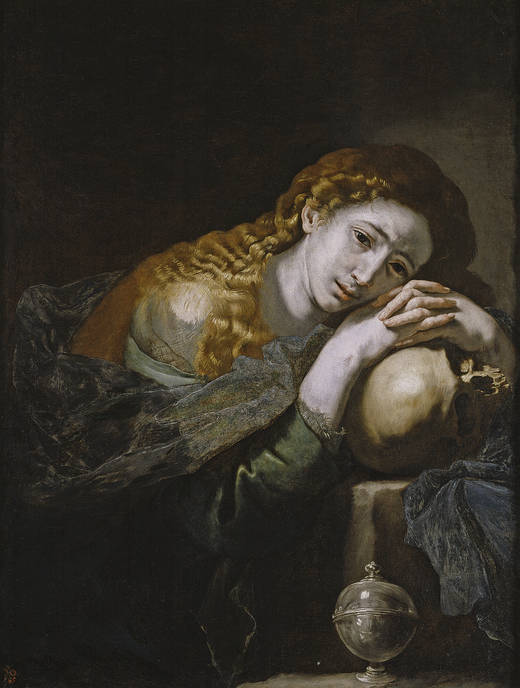
Mark 16 is the final chapter of the Gospel of Mark in the New Testament of the Christian Bible. It begins with the discovery of the empty tomb by Mary Magdalene, Mary the mother of James, and Salome. There they encounter a man dressed in white who announces the Resurrection of Jesus.
Verse 8 ends with the women fleeing from the empty tomb, and saying "nothing to anyone, because they were afraid." Many scholars take 16:8 as the original ending and believe the longer ending (16:9-20) was written later by someone else as a summary of Jesus' resurrection appearances and several miracles performed by Christians. In this 12-verse passage, the author refers to Jesus' appearances to Mary Magdalene, two disciples, and then the Eleven (the Twelve Apostles minus Judas). The text concludes with the Great Commission, declaring that believers that have been baptized will be saved while nonbelievers will be condemned, and pictures Jesus taken to Heaven and sitting at the Right Hand of God.[1]
Most scholars, following the approach of the textual critic Bruce Metzger, hold the view that verses 9-20 were not part of the original text.[1] Textual critics have identified two distinct endings—the "Longer Ending" (vv. 9-20) and the "Shorter Ending," which appear together in six Greek manuscripts, and in dozens of Ethiopic copies. The "Shorter Ending," with slight variations, runs as follows: "But they reported briefly to Peter and those with him all that they had been told. And after this, Jesus himself sent out by means of them, from east to west, the sacred and imperishable proclamation of eternal salvation."
en.wikipedia.org...
reply to post by Aleister
There is of course a very strong romantic aspect to her attatchment to the skull, and of course it was considered he loved her the most so certainly the relationship was of the closest kind.

Artemis as the sister of Apollo, is a kind of female Apollo, that is, she as a female divinity represented the same idea that Apollo did as a male divinity. This relation between the two is in many other cases described as the relation of husband and wife, and there seems to have been a tradition which actually described Artemis as the wife of Apollo.
edit on 29-3-2013 by Kantzveldt because: (no reason given)
Originally posted by Kantzveldt
reply to post by boymonkey74
Mark 16 is the final chapter of the Gospel of Mark in the New Testament of the Christian Bible. It begins with the discovery of the empty tomb by Mary Magdalene, Mary the mother of James, and Salome. There they encounter a man dressed in white who announces the Resurrection of Jesus.
Verse 8 ends with the women fleeing from the empty tomb, and saying "nothing to anyone, because they were afraid." Many scholars take 16:8 as the original ending and believe the longer ending (16:9-20) was written later by someone else as a summary of Jesus' resurrection appearances and several miracles performed by Christians. In this 12-verse passage, the author refers to Jesus' appearances to Mary Magdalene, two disciples, and then the Eleven (the Twelve Apostles minus Judas). The text concludes with the Great Commission, declaring that believers that have been baptized will be saved while nonbelievers will be condemned, and pictures Jesus taken to Heaven and sitting at the Right Hand of God.[1]
Most scholars, following the approach of the textual critic Bruce Metzger, hold the view that verses 9-20 were not part of the original text.[1] Textual critics have identified two distinct endings—the "Longer Ending" (vv. 9-20) and the "Shorter Ending," which appear together in six Greek manuscripts, and in dozens of Ethiopic copies. The "Shorter Ending," with slight variations, runs as follows: "But they reported briefly to Peter and those with him all that they had been told. And after this, Jesus himself sent out by means of them, from east to west, the sacred and imperishable proclamation of eternal salvation."
en.wikipedia.org...
reply to post by Aleister
There is of course a very strong romantic aspect to her attatchment to the skull, and of course it was considered he loved her the most so certainly the relationship was of the closest kind.
Artemis as the sister of Apollo, is a kind of female Apollo, that is, she as a female divinity represented the same idea that Apollo did as a male divinity. This relation between the two is in many other cases described as the relation of husband and wife, and there seems to have been a tradition which actually described Artemis as the wife of Apollo.edit on 29-3-2013 by Kantzveldt because: (no reason given)
Not only lovers, but they had to be married. Had to be, for the skull to be in her control, and to travel with her. The guy had a mother still alive, and a couple of brothers, and then there were all his buddies. And this chick's going to waltz in and tell them "Dudes, I'm going to rub and cut the flesh from your bro's head, and then boil it in something, and then I'm taking the skull." "Yeah, sure Mary, we're down with that? The Virgin Mary, what do you say?" "Stop calling me that! Anyway, yeah, sure, boil my son's head and be off with his skull. That's fine."
No, it couldn't have happened like that. Mary Magd' didn't just waltz in and talk everyone into letting her take his skull. She had first dibs on it! She had to be Jesus' wife. Or at least in the artistic tradition presented in the OP. There is no other reason for that tradition to exist than to tell the viewing public (paintings were the CNN, FOX, and MSNBC of the day) that Mary Magdalene had prioritory status over the head of Jesus Christ after his death. She could have been no other than his wife.
Never knew about the skull paintings and pictures before, so the skull thing seems obvious. I like the same painting the OP likes, the one with the long hair. That painting has power and beauty both. Thanks again for posting all of them.
EDIToes anyone see a hole in this theory?
It could be she was crazy and stole the skull, and everyone just let her have it to not cause a fuss. Crazy Mary, only she would steal a skull, loony tunes, let's not alert the people we know that if they happen to see her, maybe they could help get Jesus' head back to us, to be buried with his body maybe? Hah, forget it, let her have it. Crazy Mary. Who'd believe it anyway?
Or they were "just friends" and the skull was willed her in Jesus' last will. Possible. Likely he would have just given her a lock of hair or something. Are there any other reasonable alternates that the paintings portraying Mary with Jesus' skull would have meant? I'm going with crazy, koo koo, koo koo. "Come back here with that!" Or maybe the wife thing.
edit on 29-3-2013 by Aleister because: (no reason given)
edit on 29-3-2013 by Aleister because: one word
edit
on 29-3-2013 by Aleister because: (no reason given)
Great thread with powerful art.
Major Tom: Give my wife my love...
Major Tom: Give my wife my love...
Originally posted by BlueMule
Great thread with powerful art.
Major Tom: Give my wife my love...
The next verse, which I'm sure you're pointing to. Nice symbolism. So are you in the "means she's his wife" camp, and "thanks for the skull, hon"?:
"Far beneath the ship the world is mourning
They don't realize he's alive
No one understands but Major Tom sees
Now the light commands
This is my home, I'm coming home"
Originally posted by Aleister
The next verse, which I'm sure you're pointing to. Nice symbolism.
Yuppers.
So are you in the "means she's his wife" camp, and "thanks for the skull, hon"?:
I don't know. I'm on the fence. I feel that their relationship was something profoundly archetypal and mystical, even if not socially official and recognized.
In such a case as that social conventions, social mechanisms, and worldly circumstances would not stop her from getting what she must get, or from getting to where she must be.
edit on 29-3-2013 by BlueMule because: (no reason given)
Originally posted by Kantzveldt
There was that time with the apostles Saint Maximin, which was one of the seventy-two disciples of our Lord, to whom the blessed Mary Magdalene was committed by Saint Peter, and then, when the disciples were departed, Saint Maximin, Mary Magdalene, and Lazarus her brother, Martha her sister, Marcelle, chamberer of Martha, and Saint Cedony which was born blind, and after enlumined of our Lord; all these together, and many other christian men were taken of the miscreants and put in a ship in the sea, without any tackle or rudder, for to be drowned. But by the purveyance of Almighty God they came all to Marseilles, where, as none would receive them to be lodged, they dwelled and abode under a porch tofore a temple of the people of that country
Hmm.
reply to post by BlueMule
Thanks, this is where i'm coming from...
let me put you in the picture, let me show you what i mean...
Thanks, this is where i'm coming from...
let me put you in the picture, let me show you what i mean...
reply to post by AthlonSavage
Nice, i also wrote a poem;
Oh dear Magdalena
an allure in purple hue
the seeing all that mattered here
was knowing days of you
From the city of the Angels
ventured forth to rule as Queen
that elusive object of desire
in pursuit of distant dream
In deepest depths of winter chill
breath it formed ethereal mists
as began the game of love
eyes they met and lips were kissed
Heading off o'er frozen stone
that glittered brightly frosted
the star encrusted mystic bridge
well that was where we crossed it...
Oh pure Magdalena
dovelike vision linen white
Untouchable realm of sanctity
gentle presence in the night
Through silent sombre sleeping woods
we'd walk across this land
to be caressed by dreamlike fog
and ever hand in hand
As warmer winds began to blow
bringing rainfall from the west
the storm that came at setting sun
blew as passion without rest
The morn' that followed was so still
the world it looked the same
but high in Heaven talk was rife
of who should take the blame...
Oh sweet Magdalena
fragrant bloom of madder rose
eyes in softest hazel brown
loveliness held close
Re-awake as gentle spring
when buds shyly do emerge
flowers of woodland and of meadow
all caught up in the urge
Renewed with purpose and endeavour
reaching upward ever higher
nature spreads her blessings forth
we climbed gothic spire
The birds were happy in the nest
and all life it seemed good
but the chick that fell unseen to ground
left faintest speck of blood...
Oh dour Magdalena
madent face with black hair cover
tearful offerings fall to Earth
in honour of the mother
Can the sun in all its glory
be thought of risen too soon
if in the fullness of its splendour
eclipsed by soulful moon
Spiders weave their webs unseen
thus lines of fate are spun
and no surprise is felt so sharp
than end of scarce begun
The eerie chill thus passed away
like spectral apparition
that sighs however as it parts
'not all seeds bear fruition'...
Oh radiant Magdalena
aglow in beams of golden sun
dance now gentle butterfly
for summer has begun
Merry flowers opened to the light
the air was filled with hum of bees
field mice gathered up the grain
bird song floated on the breeze
Milk and honey in the larder
a time of plenty and of ease
days of pleasure in contentment
hearts of poets did apease
Warm rain begins to gently fall
a face ecstatic caught in rapture
perfect moments oh how they pass
and what thing does the artist capture...
Oh dreamy Magdalena
sublime perfection clothed in blue
like mystic fruit from off the vine
sweet to the lips and ever true
That precious necklace of the skies
jewel like rainbow shining bright
appeared amidst the ambling clouds
and all within the world seemed right
Gliding through still waters
so crystal clear and pure
drawing forth an immaculate veil
toward the horizon of azure
A harvest then was gathered in
placed in rectangle bound with number
angels turned their face away
as hope eternal began her slumber...
Oh bitter Magdalena
autumn leaves in lemon yellow
malignant doubt she must increase
and rings make sounding hollow
The tide began to slowly turn
were once was praise now scorn
as darkness gathered all around
romance seemed so forlorn
Stranded helpless on the shore
the waves far out of reach
i grasped a handful of the sand
on sad abandoned beach
Rancid seaweed twisted driftworod
rotting fish and bloated flies
cautious crabs walk ever sideways
maybe some tell lies...
Oh distant Magdalena
a silver star occluded
time drifts slowly ever by
still dreamers are deluded
A hurtful wound within my side
were crescent rib was taken
the fullness of the moon that waxed
e'rr love became forsaken
All the fear and all the pain
that life it has to give
you suffer these and then can say
i do believe i live
Words of promise and of trust
we often give when starting
yet declarations of true love
seemed strange to me in parting...
Nice, i also wrote a poem;
Oh dear Magdalena
an allure in purple hue
the seeing all that mattered here
was knowing days of you
From the city of the Angels
ventured forth to rule as Queen
that elusive object of desire
in pursuit of distant dream
In deepest depths of winter chill
breath it formed ethereal mists
as began the game of love
eyes they met and lips were kissed
Heading off o'er frozen stone
that glittered brightly frosted
the star encrusted mystic bridge
well that was where we crossed it...
Oh pure Magdalena
dovelike vision linen white
Untouchable realm of sanctity
gentle presence in the night
Through silent sombre sleeping woods
we'd walk across this land
to be caressed by dreamlike fog
and ever hand in hand
As warmer winds began to blow
bringing rainfall from the west
the storm that came at setting sun
blew as passion without rest
The morn' that followed was so still
the world it looked the same
but high in Heaven talk was rife
of who should take the blame...
Oh sweet Magdalena
fragrant bloom of madder rose
eyes in softest hazel brown
loveliness held close
Re-awake as gentle spring
when buds shyly do emerge
flowers of woodland and of meadow
all caught up in the urge
Renewed with purpose and endeavour
reaching upward ever higher
nature spreads her blessings forth
we climbed gothic spire
The birds were happy in the nest
and all life it seemed good
but the chick that fell unseen to ground
left faintest speck of blood...
Oh dour Magdalena
madent face with black hair cover
tearful offerings fall to Earth
in honour of the mother
Can the sun in all its glory
be thought of risen too soon
if in the fullness of its splendour
eclipsed by soulful moon
Spiders weave their webs unseen
thus lines of fate are spun
and no surprise is felt so sharp
than end of scarce begun
The eerie chill thus passed away
like spectral apparition
that sighs however as it parts
'not all seeds bear fruition'...
Oh radiant Magdalena
aglow in beams of golden sun
dance now gentle butterfly
for summer has begun
Merry flowers opened to the light
the air was filled with hum of bees
field mice gathered up the grain
bird song floated on the breeze
Milk and honey in the larder
a time of plenty and of ease
days of pleasure in contentment
hearts of poets did apease
Warm rain begins to gently fall
a face ecstatic caught in rapture
perfect moments oh how they pass
and what thing does the artist capture...
Oh dreamy Magdalena
sublime perfection clothed in blue
like mystic fruit from off the vine
sweet to the lips and ever true
That precious necklace of the skies
jewel like rainbow shining bright
appeared amidst the ambling clouds
and all within the world seemed right
Gliding through still waters
so crystal clear and pure
drawing forth an immaculate veil
toward the horizon of azure
A harvest then was gathered in
placed in rectangle bound with number
angels turned their face away
as hope eternal began her slumber...
Oh bitter Magdalena
autumn leaves in lemon yellow
malignant doubt she must increase
and rings make sounding hollow
The tide began to slowly turn
were once was praise now scorn
as darkness gathered all around
romance seemed so forlorn
Stranded helpless on the shore
the waves far out of reach
i grasped a handful of the sand
on sad abandoned beach
Rancid seaweed twisted driftworod
rotting fish and bloated flies
cautious crabs walk ever sideways
maybe some tell lies...
Oh distant Magdalena
a silver star occluded
time drifts slowly ever by
still dreamers are deluded
A hurtful wound within my side
were crescent rib was taken
the fullness of the moon that waxed
e'rr love became forsaken
All the fear and all the pain
that life it has to give
you suffer these and then can say
i do believe i live
Words of promise and of trust
we often give when starting
yet declarations of true love
seemed strange to me in parting...
edit on 29-3-2013 by Kantzveldt because: (no reason given)
new topics
-
How To Spot Fake U.F.O. Photos
Aliens and UFOs: 4 hours ago -
Scary video of face in an abandoned house
Paranormal Studies: 6 hours ago -
Just Came Across These Unusual Old UFO Pics
Aliens and UFOs: 8 hours ago -
LA Mayor Bass Demanded $49M in Additional LAFD Cuts One Week Before Wildfires
Mainstream News: 10 hours ago -
Sepultura - Territory - With New Drummer Greyson Nekrutman
Music: 11 hours ago -
Carry On!
Short Stories: 11 hours ago
top topics
-
This should be plastered all over the airwaves
Mainstream News: 17 hours ago, 24 flags -
LA Mayor Bass Demanded $49M in Additional LAFD Cuts One Week Before Wildfires
Mainstream News: 10 hours ago, 17 flags -
Just Came Across These Unusual Old UFO Pics
Aliens and UFOs: 8 hours ago, 7 flags -
Scary video of face in an abandoned house
Paranormal Studies: 6 hours ago, 5 flags -
How To Spot Fake U.F.O. Photos
Aliens and UFOs: 4 hours ago, 4 flags -
Carry On!
Short Stories: 11 hours ago, 3 flags -
Sepultura - Territory - With New Drummer Greyson Nekrutman
Music: 11 hours ago, 2 flags
active topics
-
Los Angeles brush fires latest: 2 blazes threaten structures, prompt evacuations
Mainstream News • 390 • : AlroyFarms -
Judge rules president-elect Donald Trump must be sentenced in 'hush money' trial
US Political Madness • 121 • : WeMustCare -
Candidate TRUMP Now Has Crazy Judge JUAN MERCHAN After Him - The Stormy Daniels Hush-Money Case.
Political Conspiracies • 2191 • : WeMustCare -
A Flash of Beauty: Bigfoot Revealed ( documentary )
Cryptozoology • 13 • : SteamyAmerican -
FBI Says IRAN is Trying to Kill Candidate TRUMP - But UKRAINE May Be a Greater Danger.
2024 Elections • 15 • : WeMustCare -
How To Spot Fake U.F.O. Photos
Aliens and UFOs • 2 • : gort69 -
-@TH3WH17ERABB17- -Q- ---TIME TO SHOW THE WORLD--- -Part- --44--
Dissecting Disinformation • 3989 • : WeMustCare -
Old School Punk
Music • 566 • : underpass61 -
To become president, Zelensky had to learn Ukrainian
Political Conspiracies • 44 • : SteamyAmerican -
This should be plastered all over the airwaves
Mainstream News • 55 • : Astrocometus
